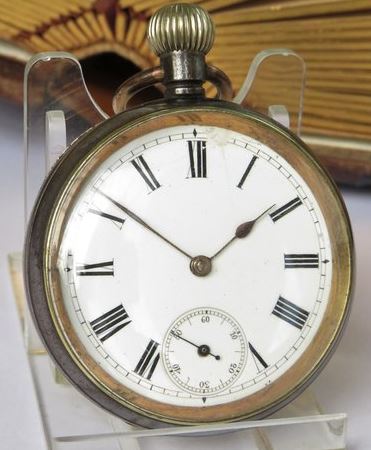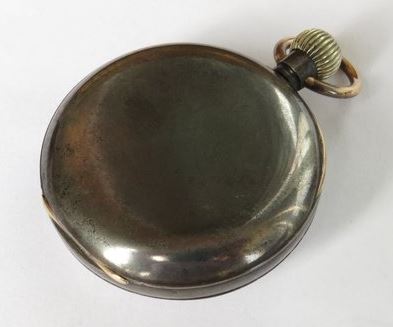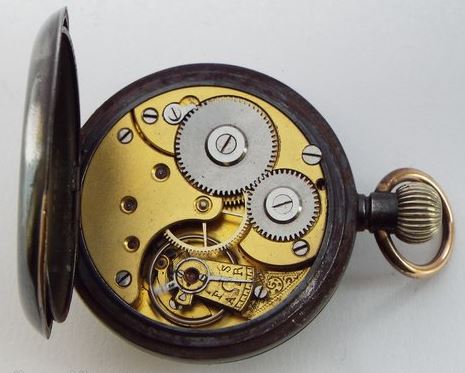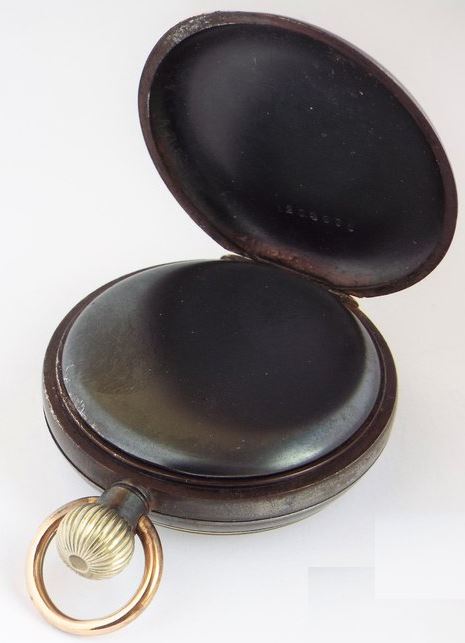Last updated on June 23, 2024
As I have posted recently, I am on the lookout for a hunter cased antique pocket watch as the next addition to my collection. Despite my enforced Coronavirus isolation and the extra time afforded to me to search for such a timepiece, I am out of luck. However, this has given me the opportunity to view many more antique watches online. Today’s post is about an antique gunmetal pocket watch by Omega. Although this particular antique pocket watch doesn’t really match my criteria of presentability, it interests me because of the movement manufacturer, Omega, and the case material, gunmetal.

Omega
Louis Brandt founded Omega in 1848 in La Chaux-de-Fonds, Switzerland. Initially, the company was known as La Generale Watch Co. until incorporating the name Omega in 1903. In the beginning, Brandt assembled key-wound pocket watches made from parts supplied by local craftsmen. In 1885, Brandt’s sons Louis-Paul and César developed an in-house manufacturing system that created interchangeable components and the company began producing their own movements. Omega watches were used by the British Royal Flying Corps as official timekeepers for their combat units, much later Omega watches were the choice of NASA for their moon missions. Omega is definitely on the list for my collection and at some point, I will definitely purchase an antique pocket watch by this famous maker.
Gunmetal
Gunmetal is an interesting choice for case material. It is an alloy formed of copper, tin and zinc. Originally, it was mainly used, as the name suggests, for making guns. It is highly resistant to corrosion from steam and saltwater. It also has a dark appearance and lacks the shine and glamour of silver or gold. However, I did find another description of gunmetal that might have been used for watch cases. This is where steel is treated with caustic soda to produce an outer layer with a dark black finish that is moderately corrosion resistant.
I am not sure which of these types has been used for this watch case. However, it definitely has that dark, slightly dirty and tarnished appearance that is common with both types. It’s the grimy appearance that doesn’t really match my criteria of presentability. I imagine watches with gunmetal cases were used by workmen or the military where the corrosion resistance was more important than appearance. I couldn’t see myself wearing this timepiece with a dinner suit.
Subsequent research suggests that gunmetal watch cases are in fact made of steel that has been through an oxidisation process. This procedure involves immersing the steel case parts in a caustic solution at about 180 degrees centigrade. This gives the steel a small amount of resistance to rust and corrosion.

Movement
The watch has a stem-wind, stem-set movement which is working within two to three minutes of accuracy a day. This is certainly reliable enough for occasional use. The movement is signed with the Omega logo on the balance cock and can also be identified as being by Omega from the shape of the plates. As with early Omega pocket watches, the serial number will be visible underneath the dial. The movement is protected by an inner hinged cover.

Case
The watch measures 47.2mm in diameter excluding the winding stem and the loop. It is a little smaller than the other pocket watches in my collection. The gunmetal case is in good condition and has rose gold embellishments. The case has light surface marking from use, but no obvious dents or damage which is common in watches of this age. Overall, it is in good condition for an early 1900s piece. The mineral watch glass is in nice condition with no obvious marks visible in the photos. However, magnification would probably show up with some minor markings.

Dial
The white enamel dial is clear and clean. The dial was left blank on purpose for the retail jeweller to add their branding if required. Apparently, there are a couple of hairline cracks and an old repair to the outer edge between 12 & 1 o’clock. The watch has its original gold hands and a blued steel sub-seconds hand. Bluing steel is a process that tempers the steel and creates an oxidised coating that helps to prevent the steel from rusting. The steel hands are cleaned and polished. Next, the hands are heated, over a bed of brass filings, to a high temperature. The layer of brass filings is used to maintain a constant temperature exchange. The steel changes colour from gold to brown and then purple before it settles to blue.
It’s a very interesting antique pocket watch and I certainly want to add an Omega to my collection at some point. However, in this instance, the gunmetal case doesn’t meet my criteria of presentability. If anyone is interested I can highly recommend the seller, The Vintage Wrist Watch Company, I have bought several antique watches from them and have never been disappointed.
